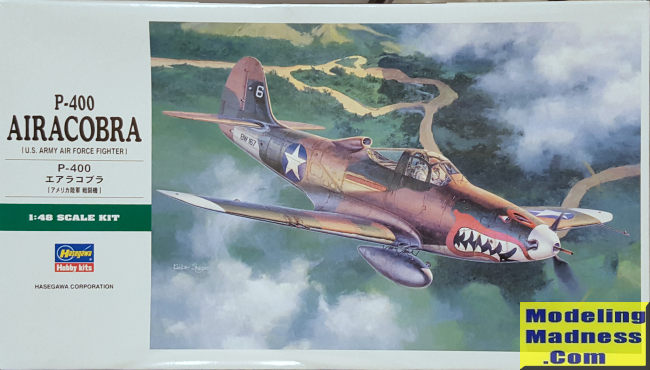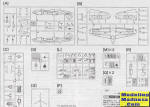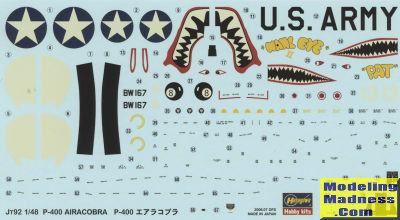
Hasegawa 1/48 P-400 Airacobra
| KIT #: | 09092 |
| PRICE: | 2400 yen |
| DECALS: | Two options |
| REVIEWER: | Scott Van Aken |
| NOTES: | 2006 basic boxing |

| HISTORY |
200 examples intended for the RAF were taken up by the USAAF after the attack on Pearl Harbor as the P-400, and were sent to the Fifth Air Force in Australia, for service in the South West Pacific Theatre. While Lt. Bill Fiedler was the only American pilot to become an ace in a P-39, many later U.S. aces scored one or two of their victories in the type. The Airacobra's low-altitude performance was good and its firepower was impressive. It soon became a joke in the Pacific Theatre that a P-400 was a P-40 with a Zero on its tail.
| THE KIT |
 In
line with other Hasegawa single engine fighters, this one has a nicely done
cockpit. There are decals for the instrument panels or you can paint the nice
detail provided. The cockpit floor attaches to the nose gear well. This kit
provides a section of drive shaft to go into the well. Atop the floor there is
the usual detail that includes control sticks, rudder pedals, seat frame, seat,
and the panel that goes behind it. There is also the armored glass panel for the
bulkhead behind the seat.
In
line with other Hasegawa single engine fighters, this one has a nicely done
cockpit. There are decals for the instrument panels or you can paint the nice
detail provided. The cockpit floor attaches to the nose gear well. This kit
provides a section of drive shaft to go into the well. Atop the floor there is
the usual detail that includes control sticks, rudder pedals, seat frame, seat,
and the panel that goes behind it. There is also the armored glass panel for the
bulkhead behind the seat.
When one closes the cockpit into the fuselage halves, you'll need 15 grams of nose weight. Fortunately, there is a lot of room. When it comes to the wings, there are holes to open in the lower wing if you want to have a drop tank/bomb on the centerline. There are also inserts for the lower wing that contain the shell ejection chutes for the outer wing guns. Before attaching the wings, if you want clear formation lights, you have to cut away the molded in versions.
The P-400 has the exhaust that has twelve stacks on
each side that are pretty much one of the features of the P-400. There is an
insert for the upper cowling. When you build up the prop, there is a poly-cap to
hold it in place. The landing gear is nicely formed as are the usual struts.
Note that it
would probably be easier to attach the main outer gear door to the strut before
gluing it in place. Doors are separate so you can model one or more open if you
so wish.
it
would probably be easier to attach the main outer gear door to the strut before
gluing it in place. Doors are separate so you can model one or more open if you
so wish.
Instructions are typical Hasegawa fare with Gunze paints. Two options are provided both in US-equivalent RAF colors. The box art plane is with the 67th FS on Guadalcanal in 1942. The other also has a shark mouth and is with the 39th FS in New Guinea, also in 1942. Decal sheet is nicely done, but be beware that it has off white instead of white. They will also require fairly hot water to break free from the sheet fairly quickly.
| CONCLUSIONS |
This is the one 1/48 Airacobra kit I have not built. The others I have done are the Monogram and Eduard kit. Both of those kits make very nice models when done and I'm sure that the Hasegawa kit will be just as nice to build.
| REFERENCES |
https://en.wikipedia.org/wiki/Bell_P-39_Airacobra
May 2020 Copyright ModelingMadness.com.
All rights reserved. If you would like your product reviewed fairly and fairly quickly, please
contact
the editor
or see other details in the
Note to
Contributors.
Back to the Main Page
Back to the Review
Index Page
Back to the Previews Index Page